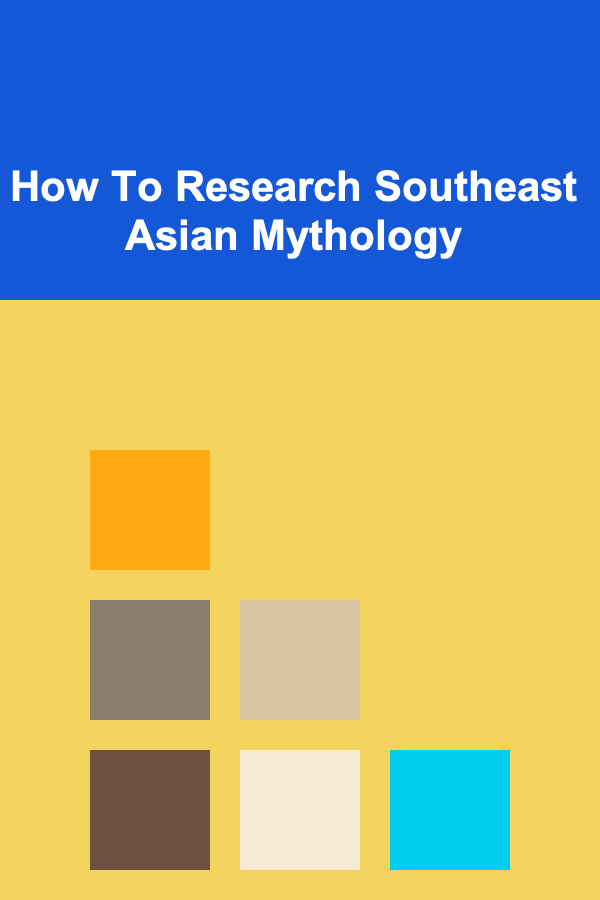
How To Research Southeast Asian Mythology
ebook include PDF & Audio bundle (Micro Guide)
$12.99$7.99
Limited Time Offer! Order within the next:

Southeast Asian mythology is a vast and rich field that encompasses a wide array of beliefs, stories, and traditions from countries in the region, including Thailand, Indonesia, Malaysia, the Philippines, Vietnam, Laos, Cambodia, and Myanmar. These mythologies often intertwine with religious practices, cultural rituals, and historical events, offering a unique insight into the worldview of the peoples of this region. Researching Southeast Asian mythology requires a nuanced understanding of the region's diverse cultures, languages, and religious traditions.
In this article, we will explore the steps, methods, and resources that can help in conducting thorough and insightful research on Southeast Asian mythology. We will examine key concepts, approaches, and challenges, and offer practical guidance on how to immerse oneself in the fascinating world of myths, legends, and folklore from Southeast Asia.
Understanding Southeast Asian Mythology
1.1 What is Southeast Asian Mythology?
Southeast Asian mythology consists of a wide range of mythological systems, stories, and deities that originate from the region's distinct cultural and historical backgrounds. It reflects the diversity of religious beliefs, including animism, Hinduism, Buddhism, Islam, and indigenous traditions. These mythologies explore creation myths, heroic epics, divine intervention, spirits, and supernatural creatures, and serve to explain natural phenomena, social customs, and the cosmos.
Each country in Southeast Asia has its own pantheon of gods, spirits, and folklore. For example, Hindu and Buddhist mythologies significantly influence Thailand, Cambodia, and Indonesia, while animistic beliefs dominate parts of Malaysia, the Philippines, and Laos. The shared geographical proximity, however, results in overlapping mythological elements, often leading to a cross-pollination of stories and ideas.
1.2 Importance of Mythology in Southeast Asian Culture
Mythology in Southeast Asia is deeply intertwined with culture, identity, and religion. It plays an essential role in preserving cultural traditions, understanding the world, and passing down wisdom across generations. Myths and folklore often address fundamental human questions about life, death, morality, and the relationship between humans and nature. These stories are passed down orally through generations, making them an important aspect of Southeast Asia's intangible cultural heritage.
Myths and religious beliefs in Southeast Asia are often closely linked to festivals, rituals, art, and literature. In many Southeast Asian societies, mythological figures appear in architecture, sculpture, paintings, and performances, reflecting their deep-rooted influence in everyday life.
Preparing for Research
2.1 Identify the Region or Culture
The first step in researching Southeast Asian mythology is to identify which specific country or culture you want to focus on. Southeast Asia is home to a large number of distinct cultures, languages, and religions, and each country has its own mythological traditions.
- Hindu and Buddhist Influence: Countries like Thailand, Cambodia, and Indonesia have been heavily influenced by Hindu and Buddhist cosmologies, leading to a rich tradition of gods, demons, and spiritual teachings.
- Islamic and Animistic Mythologies: Malaysia, Indonesia, and the Philippines also have strong Islamic influences, alongside the remnants of indigenous animistic beliefs that worship spirits of nature, ancestors, and animals.
- Indigenous Traditions: Indigenous groups in Southeast Asia, such as the Dayak in Borneo and the Negrito of the Philippines, have distinct mythologies that focus on nature spirits, ancestor worship, and the supernatural.
Understanding the dominant religious and cultural influences in a particular area will help narrow down your research and make it more manageable.
2.2 Study the Sources
Mythologies in Southeast Asia are found in a variety of forms, including oral traditions, religious texts, and folklore collections. The primary sources for researching these myths often include:
- Oral Traditions: Many Southeast Asian myths and legends are passed down orally through storytelling, songs, and performances. Researching these requires fieldwork, listening to oral storytellers, and documenting local oral traditions.
- Sacred Texts and Scriptures : In countries with strong Hindu, Buddhist, or Islamic influences, sacred texts such as the Ramayana , Mahabharata , Dhammapada , and Quran contain rich mythological references.
- Historical Documents and Manuscripts: Historical texts, manuscripts, and chronicles can also shed light on the mythological beliefs of Southeast Asian cultures. These include texts written in ancient languages such as Sanskrit, Pali, and Malay, as well as colonial-era documents that discuss local myths and religions.
- Folklore and Folklorists: Folklorists and ethnographers have documented myths, legends, and traditions in books, articles, and collections. Authors such as W. Somerset Maugham, R.A. Schwaller de Lubicz, and Clifford Geertz have contributed valuable insights into the mythologies of Southeast Asia.
2.3 Language Considerations
Language plays a significant role in understanding Southeast Asian mythology. Many of the original texts are written in languages such as Sanskrit, Pali, Javanese, Malay, or Thai. For researchers who do not speak these languages, it may be necessary to collaborate with local experts or rely on translated works.
Learning the basics of the relevant languages can significantly enhance your understanding of the nuances and cultural context of the myths. For instance, understanding Sanskrit or Pali can provide deeper insights into Hindu and Buddhist mythological concepts that pervade Southeast Asian cultures.
Approaches to Researching Southeast Asian Mythology
3.1 Comparative Mythology
One useful approach to researching Southeast Asian mythology is through comparative mythology, which involves comparing the myths of different cultures to identify shared themes, archetypes, and motifs. Southeast Asian mythologies often share common features, such as creation stories, flood myths, and the personification of natural forces.
For example, many Southeast Asian cultures have similar stories of a great flood, such as the Javanese Kisah Sang Hyang Tunggal or the Philippine epic of the Maguindanao, where a flood destroys the world and a select few survivors rebuild humanity. Comparing these versions of the flood myth can reveal both unique cultural interpretations and shared universal themes across the region.
3.2 Fieldwork and Ethnography
Another critical method for researching Southeast Asian mythology is ethnographic fieldwork. Ethnography involves direct observation, participation, and interviews with people who are part of the culture you are studying. In Southeast Asia, this means traveling to rural villages, engaging with local communities, and listening to storytellers, shamans, and elders who preserve oral traditions.
Fieldwork is essential for documenting myths that may not be written down, as many stories exist only in spoken form. Ethnographers often work alongside local historians, anthropologists, and folklore experts to collect and analyze mythological material.
3.3 Interdisciplinary Approach
Researching Southeast Asian mythology benefits from an interdisciplinary approach. Mythology is not just about stories; it's deeply connected to history, religion, sociology, anthropology, and art. Researchers should be open to drawing from different academic fields to gain a more holistic understanding of the myths.
- History: Mythology often intersects with historical events, such as colonialism, wars, or migrations. Understanding these contexts can deepen the meaning of myths and how they evolved over time.
- Anthropology: Anthropology offers insights into the cultural practices surrounding mythologies, such as religious rituals, festivals, and ceremonies.
- Art History: Southeast Asian mythology is vividly represented in art, architecture, and sculpture. Understanding the artistic depictions of myths can provide a visual dimension to your research.
3.4 Understanding Symbolism and Archetypes
A key aspect of Southeast Asian mythology is the use of symbolism and archetypes. Many Southeast Asian myths involve animals, nature spirits, celestial beings, and divine heroes. These symbols often represent larger concepts such as balance, harmony, or moral lessons. Understanding the symbolic meaning behind certain animals, colors, and objects in mythology is crucial to unlocking the deeper messages in the myths.
For instance, in Javanese mythology, the mythical bird Garuda is both a symbol of divine power and a creature of immense strength. In Thai and Cambodian mythology, the Garuda is often associated with the sun and with royal symbolism, particularly with the king's power. Understanding these symbolic meanings across different cultures will help you interpret and compare mythological stories more effectively.
Challenges in Researching Southeast Asian Mythology
4.1 Language and Translation Barriers
Language can be a significant challenge when researching Southeast Asian mythology, as many texts are written in ancient languages like Sanskrit, Pali, or Old Javanese, and modern Southeast Asian languages often have distinct dialects. Translating these ancient texts requires not only linguistic skills but also an understanding of the cultural context in which they were written.
While many texts are available in English or other languages, the translation process can sometimes lose nuance or meaning. Researchers should be aware of these limitations and consult multiple translations or work directly with local scholars to ensure accuracy.
4.2 Availability of Sources
Many Southeast Asian myths and legends exist primarily in oral form, and only a limited number have been transcribed or documented. While some myths have been preserved through sacred texts, historical accounts, and folklore collections, much of the traditional knowledge is at risk of being lost. Researchers must make efforts to document oral traditions before they vanish, especially in rural or remote areas.
4.3 Cultural Sensitivity
When researching mythologies from any culture, including Southeast Asia, cultural sensitivity is crucial. Researchers must approach the subject with respect and avoid imposing Western perspectives or interpretations on the myths. Many myths and stories may have deeply spiritual meanings for local communities, and it is important to honor these beliefs when conducting research.
Resources for Research
5.1 Libraries and Academic Journals
Many universities and academic institutions offer access to scholarly resources on Southeast Asian mythology. Libraries may have books, articles, and ethnographic studies on specific mythologies, gods, and legends. Academic journals such as Asian Folklore Studies , The Journal of Southeast Asian Studies , and Asian Ethnology publish articles on mythology, folklore, and religion in Southeast Asia.
5.2 Online Databases and Digital Archives
Several digital resources provide access to mythological texts, folklore collections, and ethnographic studies. Websites like the Digital Library of Southeast Asian Studies and the Asia Pacific Digital Library host texts, images, and audio recordings of myths and legends from the region.
5.3 Fieldwork and Expert Collaboration
As mentioned earlier, fieldwork is an essential method for collecting myths that are not documented in written form. Collaborating with local researchers, anthropologists, and folklore experts can help gain access to primary sources and provide guidance on how to interpret local myths and traditions.
Conclusion
Researching Southeast Asian mythology is a fascinating and rewarding journey into the cultural, religious, and historical fabric of the region. By understanding the diversity of beliefs, embracing interdisciplinary research methods, and respecting the cultural context of these myths, researchers can gain valuable insights into the symbolic world of Southeast Asian peoples.
While the challenges of language barriers, availability of sources, and cultural sensitivity can make this research complex, they are also what make the study of Southeast Asian mythology so enriching. Through careful study and collaboration, we can help preserve and celebrate these timeless myths and legends for future generations.
Other Products

Creative Tips for Cutting Back on Eating Out Without Sacrificing Flavor
Read More
How to Create a Functional Mudroom with Effective Storage Solutions
Read More
How to Organize Volunteer Training Materials Effectively
Read More
How to Schedule Regular Family Meetings for Open Communication
Read More
How to Set Up an Online Store to Sell Your Homemade Soap
Read More